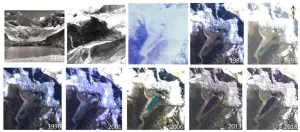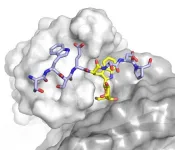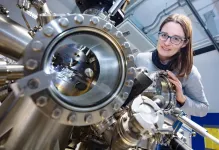(Press-News.org) As the planet warms, glaciers are retreating and causing changes in the world's mountain water systems. For the first time, scientists at the University of Oxford and the University of Washington have directly linked human-induced climate change to the risk of flooding from a glacial lake known as one of the world's greatest flood risks.
The study examined the case of Lake Palcacocha in the Peruvian Andes, which could cause flooding with devastating consequences for 120,000 residents in the city of Huaraz. The paper, published Feb. 4 in Nature Geoscience, provides new evidence for an ongoing legal case that hinges on the link between greenhouse gas emissions and particular climate change impacts.
"The scientific challenge was to provide the clearest and cleanest assessment of the physical linkages between climate change and the changing flood hazard," said co-author Gerard Roe, a UW professor of Earth and space sciences.
In 2016, Roe and colleagues developed a method to determine whether an individual glacier's retreat can be linked to human-induced climate change. The retreat of mountain glaciers has several consequences, including creating basins in the space left by the retreating glacier. Precipitation and meltwater collects in these basins to form glacial lakes. Recent work has shown a rapid worldwide growth in the number and size of high-elevation glacial lakes.
"We believe our study is the first to assess the full set of linkages between anthropogenic climate change and the changing glacial lake outburst flood hazard," Roe said. "The methods used in our study can certainly be applied to other glacial lakes around the world."
The new study first calculated the role of human emissions in the observed temperature increase since the start of the industrial era around Palcaraju Glacier. It finds that human activity is responsible for 95% of the observed 1 degree Celsius (1.8 degrees Fahrenheit) warming in this region since 1880.
The authors then used the UW-developed technique to assess the relationship between these warming temperatures and the observed long-term retreat of the glacier that has caused Lake Palcacocha to expand. Results show it is virtually certain, with greater than 99% probability, that human-induced climate change has caused Palcaraju Glacier's retreat.
Lead author Rupert Stuart-Smith, a doctoral student at Oxford, then used two methods to assess the hazard of glacial lake outburst flooding, in which an avalanche, landslide or rockfall induces a tsunami wave that overtops the lake's banks, to pinpoint how Lake Palcacocha's growth affects the flood risk faced by the city of Huaraz below.
"We found that human influence on climate -- through greenhouse-gas emissions -- is responsible for virtually all of the warming that has been observed in the region," said Stuart-Smith, who spent the summer of 2019 at the UW. "The study shows that warming has caused the retreat of the Palcaraju Glacier, which in turn has greatly increased the flood risk."
The study provides new evidence for an ongoing case in the German courts in which Saúl Luciano Lliuya, a farmer from Huaraz, has sued RWE, Germany's largest electricity producer, for its role in creating global warming. The suit seeks reimbursement for current and future flood-risk reduction measures.
"Crucially, our findings establish a direct link between emissions and the need to implement protective measures now, as well as any damages caused by flooding in the future," Stuart-Smith said.
This is not the first time Huaraz has been threatened by climate change. In 1941, an outburst flood from Lake Palcacocha, resulting from an ice and rock slide, killed at least 1,800 people. The study also found this flood to be influenced by human-induced climate change -- making it one of the earliest identified fatal impacts of climate change.
The lake's recent growth strains decades of engineering efforts since the 1970s to contain the lake's water.
"Around the world, the retreat of mountain glaciers is one of the clearest indicators of climate change," Roe said. "Outburst floods threaten communities in many mountainous regions, but this risk is particularly severe in Huaraz, as well as elsewhere in the Andes and in countries like Nepal and Bhutan, where vulnerable populations live in the path of the potential floodwaters."
INFORMATION:
Other co-authors are Myles Allen and Sihan Li at the University of Oxford. The study was funded by the U.K. Natural Environment Research Council, the U.S. National Science Foundation and a grant from the University of Oxford.
For more information, contact Roe at groe@uw.edu or Stuart-Smith at rupert.stuart-smith@ouce.ox.ac.uk.
CHICAGO - A new study by Northwestern University researchers finds involvement with firearms by high-risk youth is associated with firearm violence during adulthood.
"Association of Firearm Access, Use, and Victimization During Adolescence with Firearm Perpetration During Adulthood in a 16-year Longitudinal Study of Youth Involved in the Juvenile Justice System" will publish in JAMA Network Open at 10 a.m. CST, Thursday, Feb. 4. Access the full study online.
The longitudinal study of juvenile justice youth is the first to analyze firearm victimization and access during adolescence and its association with firearm violence in adulthood.
The study is based ...
Toronto - (February 4, 2021) The results of a Phase III randomized clinical trial have shown that when it comes to detecting clinically significant prostate cancer, Magnetic Resonance Imaging (MRI) with targeted biopsies (MRI-TBx) matches the current standard and brings a multitude of advantages. The PRostate Evaluation for Clinically Important Disease: MRI vs Standard Evaluation Procedures (PRECISE) study will help to make prostate cancer diagnosis more accurate and less invasive.
PRECISE included 453 participants at Canadian academic cancer centres who were either assigned to receive MRI ...
What The Study Did: Researchers estimated the rate of nurse burnout in the United States and the factors associated with leaving or considering leaving their jobs due to burnout.
Authors: Megha K. Shah, M.D., M.Sc., of the Emory University School of Medicine in Atlanta, is the corresponding author.
To access the embargoed study: Visit our For The Media website at this link https://media.jamanetwork.com/
(doi:10.1001/jamanetworkopen.2020.36469)
Editor's Note: The article includes conflict of interest and funding/support disclosures. Please see the article for additional information, ...
What The Study Did: Researchers in this randomized clinical trial investigated whether nasopharyngeal application of povidone iodine could reduce the viral load of patients with nonsevere COVID-19 symptoms.
Authors: Olivier Mimoz, M.D., Ph.D., University Hospital of Poitiers in Poitiers, France, is the corresponding author.
To access the embargoed study: Visit our For The Media website at this link https://media.jamanetwork.com/
(doi:10.1001/jamaoto.2020.5490)
Editor's Note: The article includes conflict of interest and funding/support disclosures. Please see the article for additional information, including other authors, author contributions and affiliations, conflict of interest and financial disclosures, ...
What The Study Did: This randomized clinical trial looked at changes in levels of the hormone estradiol in men with hormone receptor-positive breast cancer after three months of treatment with endocrine therapies.
Authors: Sibylle Loibl, M.D., Ph.D., of the German Breast Group in Neu-Isenburg, Germany, is the corresponding author.
To access the embargoed study: Visit our For The Media website at this link https://media.jamanetwork.com/
(doi:10.1001/jamaoncol.2020.7442)
Editor's Note: The article includes conflicts of interest and funding/support disclosures. Please see the article ...
CAMBRIDGE, MA -- Cryo-electron microscopy (cryo-EM) allows scientists to produce high-resolution, three-dimensional images of tiny molecules such as proteins. This technique works best for imaging proteins that exist in only one conformation, but MIT researchers have now developed a machine-learning algorithm that helps them identify multiple possible structures that a protein can take.
Unlike AI techniques that aim to predict protein structure from sequence data alone, protein structure can also be experimentally determined using cryo-EM, which produces hundreds of thousands, or even millions, of two-dimensional images of protein samples frozen in a thin layer of ice. Computer algorithms then piece together these images, taken from different angles, into a three-dimensional ...
The next time you tuck in to a tikka masala you might find yourself asking a burning question: are spices used in dishes to help stop infection?
It's a question many have chewed the fat over. And now thanks to new research from The Australian National University (ANU) we have an answer.
The quick takeaway is: probably not.
Professor Lindell Bromham and her colleagues asked why hot countries across the world tend to have spicy food? This pattern has led to what some have termed "Darwinian gastronomy" - a tummy-led cultural evolutionary process in countries with hotter climates.
To find out the answer to their question, the researchers feasted on a true ...
You might remember you ate cereal for breakfast but forget the color of the bowl. Or recall watching your partner put the milk away but can't remember on which shelf.
A new Northwestern Medicine study improved memory of complex, realistic events similar to these by applying transcranial magnetic stimulation (TMS) to the brain network responsible for memory. The authors then had participants watch videos of realistic activities to measure how memory works during everyday tasks. The findings prove it is possible to measure and manipulate realistic types of memory.
"On a day-to-day basis we must remember complex events that involve many elements, such as different locations, people and objects," said lead author Melissa Hebscher, a postdoctoral fellow ...
New tools and methods have been described by WEHI researchers to study an unusual protein modification and gain fresh insights into its roles in human health and disease.
The study - about how certain sugars modify proteins - was published today in Nature Chemical Biology. Led by WEHI researcher Associate Professor Ethan Goddard-Borger, this work lays a foundation for better understanding diseases like muscular dystrophy and cancer.
At a glance
WEHI researchers have developed new tools and methods to determine how 'tryptophan C-mannosylation', an unusual protein modification, impacts the stability and function ...
In order to produce tiny electronic memories or sensors in future, it is essential to be able to arrange individual metal atoms on an insulating layer. Scientists at Bielefeld University's Faculty of Chemistry have now demonstrated that this is possible at room temperature: molecules of the metal-containing compound molybdenum acetate form an ordered structure on the insulator calcite without jumping to other positions or rotating. Their findings have been presented in the Nature Communications journal. The work was done in cooperation with researchers from the universities of Kaiserslautern, Lincoln (UK) and Mainz.
'Until now, it has been difficult ...


